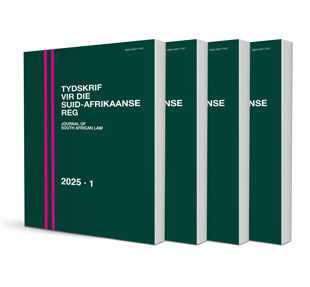Abstract
Die afgelope paar jaar het ’n beduidende toename in toegang tot, en ontwikkeling in, generatiewe kunsmatige intelligensie-tegnologieë gesien. Om teks te genereer met behulp van sogenaamde “groot taalmodelle”, of beelde te skep deur teks-na-beeld-generators, het die algemene publiek nie veel meer as ’n internetverbinding nodig nie. Die gegenereerde teks kan soms van ʼn hoër standaard wees, en die kunswerke is fyn afgewerk, wat hulle byna ononderskeibaar maak van dié wat deur mense geproduseer word, en skynbaar die vaardighede en tegnieke wat uniek is aan mense naboots. Dit is nie verbasend dat vrae oor hul status onder outeursregwetgewing ontstaan nie.
Terwyl die onderwerp van outeursreg in kunsmatige intelligensie-gegenereerde inhoud wêreldwyd oorweeg word, is min deur Suid-Afrikaanse beleidmakers gesê. Dit is nie duidelik of Suid-Afrikaanse outeursregwetgewing hierdie werke kan, of moet, beskerm nie. Hierdie artikel poog om daardie vraag te oorweeg in die lig van bestaande outeursregbepalings in die Suid-Afrikaanse Wet op Outeursreg 98 van 1978. Suid-Afrika het histories op Engelse reg gesteun waar sy eie reg nie voldoende is nie. Die Verenigde Koninkryk het voorgestel dat kunsmatige intelligensie-gegenereerde werke in hul wet op outeursreg, ontwerpe en patente van 1988 onder die kategorie van “rekenaargegenereerde werke” beskerm kan word. Die Suid-Afrikaanse Wet op Outeursreg bevat ’n soortgelyke bepaling, met verwysing na hierdie werke in paragraaf (h) van die definisie van “outeur”.
Die outeurs oorweeg in hierdie artikel of kunsmatige intelligensie-gegenereerde inhoud deur outeursreg in Suid-Afrika as ’n “rekenaargegenereerde werk” beskerm kan word. Indien dit nie as sodanig beskerm word nie, is die vraag of dit nog steeds deur outeursreg beskerm behoort te word. Die outeurs oorweeg die effek van paragraaf (h) van die definisie van “outeur” in artikel 1 van die Wet op Outeursreg. Daardeur ontleed hulle die posisie ingevolge die Engelse reg, waaruit paragraaf (h) oorgeneem is, en poog om die konsepte van rekenaargegenereerde werke en rekenaargesteunde werke te verduidelik. Die kern van hierdie kwessie is die betekenis van ’n “rekenaargegenereerde werk”.
Daar was inkonsekwentheid in die definiëring en toepassing van die “rekenaargegenereerde werke”-bepaling, wat dit moeilik maak om te peil of sowel die Engelse as die Suid-Afrikaanse wetgewers wel van plan was om werke te beskerm wat sonder enige wesenlike menslike bydrae geskep is. Of hierdie kategorie van “rekenaargegenereerde werke” inhoud insluit wat met kunsmatige intelligensie geskep is of nie, vereis beide ’n historiese oorweging sowel as ’n vooruitdenkende perspektief van die implikasies van die beskerming van hierdie kunsmatige intelligensie-gegenereerde werke, wat teen die basiese beginsels van outeursreg ontleed moet word.
Om die vraag te antwoord, moet die regverdiging vir outeursregbeskerming oorweeg word, en daar moet oorweeg word of die rasionaal vir outeursreg die werke kan akkommodeer wat nie meer die produk van menslike outeurskap is nie. Verder word gevra of die era van kunsmatige intelligensie-gegenereerde inhoud vereis dat die grondslae van outeursreg hersien en hervorm word om werke te beskerm wat hoofsaaklik die gevolg is van finansiële uitgawes, wat die onderskeid tussen outeursregte en entrepreneursregte laat vervaag.

